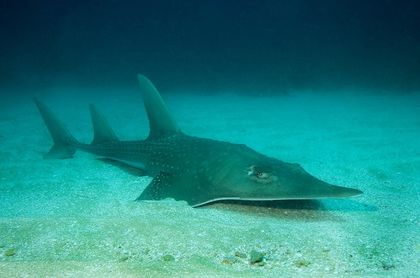One-Quarter of Sharks and Rays at Risk of Extinction
Denise Chow, Staff Writer | 21 janvier, 2014
A quarter of the world's sharks and rays are at risk of extinction, according to a new assessment by the International Union for Conservation of Nature (IUCN). The latest update to the IUCN's "Red List" of threatened species, which found ray species to be at higher risk than sharks, is part of a first-ever global analysis of these marine species.
Researchers assessed the conservation status of 1,041 shark, ray and chimaera species, which are all so-called "cartilaginous fish," meaning they have skeletons made of cartilage rather than bone. A chimaera is type of jawed fish closely related to sharks and rays.
The researchers found that sharks, rays and chimaeras face a substantially higher risk of extinction than do most other animals. In fact, only 23 percent of shark, ray and chimaera species are categorized as being safe, or of "least concern," IUCN officials said. [Gallery: Species on Endangered 'Red List']
"Our analysis shows that sharks and their relatives are facing an alarmingly elevated risk of extinction," Nick Dulvy, co-chair of the IUCN Shark Specialist Group and Canada Research Chair at Simon Fraser University in British Columbia, Canada, said in a statement. "In greatest peril are the largest species of rays and sharks, especially those living in shallow water that is accessible to fisheries," where they can become entangled in fishing gear — a phenomenon known as bycatch.
These animals are particularly threatened by overfishing, and the researchers found that reported catches of sharks, rays and chimaeras peaked in 2003 (although the scientists noted that actual catches are likely to be greatly under-reported). These catches are mostly unintentional, but there are developing markets for sharks and rays, which are adding stress to the species, IUCN officials said.
In particular, the global market for shark fins, used in shark fin soup, is severely depleting shark species, and even some ray species that have fins, such as guitarfish. These marine animals are also hunted for their meat, which can be made into products such as Chinese tonic, from manta and devil ray gills, or pharmaceuticals, from deep-sea shark livers, IUCN researchers said.
The pressure put on the species from both intentional and unintentional catches is exacerbated by the animals' relatively slow reproduction, with fish taken out of the ocean faster than they can be replaced.
"Sharks, rays and chimaeras tend to grow slowly and produce few young, which leaves them particularly vulnerable to overfishing," Sonja Fordham, deputy chair of the IUCN Shark Specialist Group and president of the Washington, D.C.-based Shark Advocates International, said in a statement.
Sharks and rays are also sometimes intentionally killed because of the perceived risk they pose to people, fishing gear or fishery targets. These types of killings are contributing to the threatened status of at least 12 species of sharks and rays, the researchers said.
"Surprisingly, we have found that the rays, including sawfish, guitarfish, stingrays and wedgefish, are generally worse off than the sharks, with five out of the seven most-threatened families made up of rays,"Colin Simpfendorfer, co-chair of the IUCN Shark Specialist Group and professor of environmental science at James Cook University in Queensland, Australia, said in a statement. "While public, media and government attention to the plight of sharks is growing, the widespread depletion of rays is largely unnoticed. Conservation action for rays is lagging far behind, which only heightens our concern for this species group."
The researchers said the depletion of sharks and rays is most pronounced in the Mediterranean Sea and the Indo-Pacific, particularly the Gulf of Thailand. The Red Sea, which lies between Africa and Asia, is also home to a high number of threatened shark and ray species, the researchers added.
"Significant policy strides have been made over the last two decades, but effective conservation requires a dramatic acceleration in pace as well as an expansion of scope to include all shapes and sizes of these exceptional species," Fordham said. "Our analysis clearly demonstrates that the need for such action is urgent."
The IUCN's assessment is the result of a collaboration among 302 experts from 64 different countries. The grim outlook, published in the journal eLIFE, comes at the start of 2014, which marks the 50th anniversary of the IUCN's Red List.
Editor's Note: This story was updated at 2:30 p.m. ET to correct that the journal eLIFE did not publish the original IUCN's Red List in 1964.
Follow Denise Chow on Twitter @denisechow. Follow LiveScience @livescience, Facebook & Google+. Original article on LiveScience.

